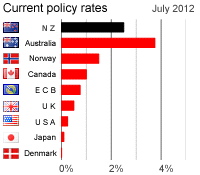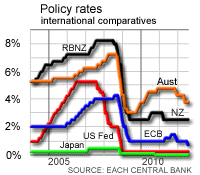 The Reserve Bank has surprised economists and financial markets by cutting the Official Cash Rate by 50 basis points to 7.5%, arguing the outlook for global growth had slowed and would in return keep inflation pressures under control. (Updated to include the NZ dollar's fall, mortgage rate cuts from Kiwibank, ASB and Westpac, and Bollard's expectations banks will cut mortgage rates).
Almost all economists had expected a 25 basis point cut to 7.75% and the decision dragged the New Zealand dollar down by almost 1 US cent to 65.2 US cents.
It is likely to drag the New Zealand dollar lower and make it easier for banks to pass on at least some of the cut to fixed and variable rate borrowers.
Kiwibank was the first to move. It passed on all of the OCR cut to its variable mortgage rate, cutting it by 50 basis points to 9.80%. It cut its two year fixed mortgage rate by 36 basis points to 8.49% and cut its 3 year rate by a similar amount to 8.39%. These rates apply to home buyers borrowing less than 80% of the home's value. ASB cut its variable mortgage rate 50 basis points to 10.25%, but cut its fixed mortgage rates by between 4 and 25 basis points. ASB cut its two year fixed mortgage rate by 5 basis points to 8.9%.
Westpac cut its variable mortgage rate by 50 basis points to 10.45%, but has left its fixed mortgage rates unchanged.
Reserve Bank Governor Alan Bollard said the 50 basis point cut gave the banks enough room to pass on some of the cut to borrowers, although he acknowledged international funding costs had risen for banks and were likely to stay high for the forseeable future.
"We think we're giving them quite a lot of room to move," Bollard told a news conference after the announcement.
"We would expect some of this to pass through and result in mortgage reductions," he said.
The Reserve Bank repeated its July 24 outlook for further rate cuts and a move to a less restrictive monetary policy stance, saying that bank funding costs remained high and would continue to remain high because of the pressures on the global financial system from the Credit Crunch.
"The New Zealand economy is experiencing a marked slowdown, led primarily by the household sector. The outlook for the global economy has deteriorated further in the wake of continued financial market turmoil," Reserve Bank Governor Alan Bollard said the September quarter monetary policy statement.
"In addition, the New Zeland business sector is coming under pressure from both rising costs and falling demand," Bollard said.
The Reserve Bank has surprised economists and financial markets by cutting the Official Cash Rate by 50 basis points to 7.5%, arguing the outlook for global growth had slowed and would in return keep inflation pressures under control. (Updated to include the NZ dollar's fall, mortgage rate cuts from Kiwibank, ASB and Westpac, and Bollard's expectations banks will cut mortgage rates).
Almost all economists had expected a 25 basis point cut to 7.75% and the decision dragged the New Zealand dollar down by almost 1 US cent to 65.2 US cents.
It is likely to drag the New Zealand dollar lower and make it easier for banks to pass on at least some of the cut to fixed and variable rate borrowers.
Kiwibank was the first to move. It passed on all of the OCR cut to its variable mortgage rate, cutting it by 50 basis points to 9.80%. It cut its two year fixed mortgage rate by 36 basis points to 8.49% and cut its 3 year rate by a similar amount to 8.39%. These rates apply to home buyers borrowing less than 80% of the home's value. ASB cut its variable mortgage rate 50 basis points to 10.25%, but cut its fixed mortgage rates by between 4 and 25 basis points. ASB cut its two year fixed mortgage rate by 5 basis points to 8.9%.
Westpac cut its variable mortgage rate by 50 basis points to 10.45%, but has left its fixed mortgage rates unchanged.
Reserve Bank Governor Alan Bollard said the 50 basis point cut gave the banks enough room to pass on some of the cut to borrowers, although he acknowledged international funding costs had risen for banks and were likely to stay high for the forseeable future.
"We think we're giving them quite a lot of room to move," Bollard told a news conference after the announcement.
"We would expect some of this to pass through and result in mortgage reductions," he said.
The Reserve Bank repeated its July 24 outlook for further rate cuts and a move to a less restrictive monetary policy stance, saying that bank funding costs remained high and would continue to remain high because of the pressures on the global financial system from the Credit Crunch.
"The New Zealand economy is experiencing a marked slowdown, led primarily by the household sector. The outlook for the global economy has deteriorated further in the wake of continued financial market turmoil," Reserve Bank Governor Alan Bollard said the September quarter monetary policy statement.
"In addition, the New Zeland business sector is coming under pressure from both rising costs and falling demand," Bollard said.
 "While domestic activity is expected to translate into lower inflation pressures in the medium term, headline inflation is expected to peak around 5% in the current September quarter before trending down thereafter. However food price inflation, exchange rate depreciation and higher wage costs will tend to keep headline inflation at elevated levels through 2009," he said.
"With medium term inflation pressures expected to ease, it is appropriate to move towards a less restrictive monetary policy stance," Bollard said.
"Compared to the June Monetary Policy Statement, we have brought forward some of the projected intrerest rate reduction, but have not altered the expected overall decline. We believe this response is warranted in light of the tightness of the current credit conditions and the time it will take to affect actual interest rates faced by households and businesses," he said.
"Looking ahead, the scale and timing of the further official cash rate reductions will depend on signs of declining inflation pressures and on exchange rate adjustments."
"While domestic activity is expected to translate into lower inflation pressures in the medium term, headline inflation is expected to peak around 5% in the current September quarter before trending down thereafter. However food price inflation, exchange rate depreciation and higher wage costs will tend to keep headline inflation at elevated levels through 2009," he said.
"With medium term inflation pressures expected to ease, it is appropriate to move towards a less restrictive monetary policy stance," Bollard said.
"Compared to the June Monetary Policy Statement, we have brought forward some of the projected intrerest rate reduction, but have not altered the expected overall decline. We believe this response is warranted in light of the tightness of the current credit conditions and the time it will take to affect actual interest rates faced by households and businesses," he said.
"Looking ahead, the scale and timing of the further official cash rate reductions will depend on signs of declining inflation pressures and on exchange rate adjustments."
Reserve Bank surprises with 50bps cut in OCR (Update 2)
Reserve Bank surprises with 50bps cut in OCR (Update 2)
11th Sep 08, 9:12am
by

We welcome your comments below. If you are not already registered, please register to comment
Remember we welcome robust, respectful and insightful debate. We don't welcome abusive or defamatory comments and will de-register those repeatedly making such comments. Our current comment policy is here.